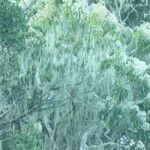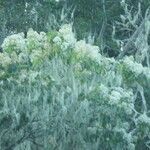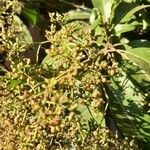Leaves ternate, opposite, decussate, or occasionally in a few lateral branchlets alternate, mostly petiolate; petiole 3–55 mm. long, glabrous or minutely pubescent; lamina coriaceous or papyraceous, elliptic, narrowly elliptic, or nearly so, 2·5–4(6) x as long as wide, 4–16 x 1–7 cm., acuminate or less often acute at the apex, cuneate at the base or decurrent into the petiole which is sometimes partly winged, dentate, crenate, or entire, glabrous or with very minute scattered glandular hairs on both sides; venation often reticulate, more or less prominent on both sides.
Tree or shrub, 2-17 m high, bark grey or grey-brown fissured, branchlets glabrous, angled, leaf scars prominent. Leaves 3-nate, blade oblong-elliptic, base cuneate, shortly or long acuminate at apex, margins entire or obscurely dentate; petioles 13-45 mm long. Inflorescences of many small white flowers in large, repeatedly dichotomous-branched panicles. Corolla white; tube included in calyx; lobes 4, erect in lower part, midway reflexed over calyx (not forming a peak or umbo in bud). Ovary glabrous. Flowering time most of the year.
Trees up to 20 m. tall or large shrubs; bark pale brownish-grey.. Lamina of leaves narrowly elliptic, up to 14 cm. long, 2–4 cm. wide, tapering above to a narrowly acute or acuminate apex, gradually convergent to a cuneate base, distantly denticulate to entire, glabrous.. Inflorescences terminal and lax,puberulous when young, glabrate.. Calyx 4 mm. long; lobes cleanly dividing.. Corolla white to yellow; lobes rounded above, glabrous.. Ovary glabrous.. Fruit almost twice the length of the calyx, glabrous.
Corolla white, outside with some minute glandular hairs at the base of the lobes and at the apex of the tube (less often on almost the entire tube), inside with a ring of slightly recurved rather thick hairs at the base of the lobes and pubescent with glandular hairs in the tube of which extreme base is glabrous; tube slightly shorter than the calyx; lobes oblong, about as long as the tube, 1–8–3–3 as long as wide, 1·8–2·2, 0·6–1 mm., acute, obtuse, or rounded at the apex.
Calyx creamy or green, often viscid, 2·5–3 .8 mm. long, minutely pubescent with glandular hairs outside, inside sparsely and/or minutely appressed–pubescent; tube about 3–5 x as long as the lobes which are equal or unequal, triangular or broadly triangular, 0·6–1·2 x 0·6–1·2 mm., acute or less often obtuse, entire or sometimes tridentate; sometimes two lobes coherent or partly united.
Stamens: filaments white, geniculate and there pilose–pubescent just above the base, and at the extreme base pubescent with glandular hairs, as the latter is situated within the zone of glandular hairs at the inner side of the corolla, after the pollen is shed 2–3·8 mm. long; anthers white, turning pale brown, about 0·5–0·6 mm. long.
Forest tree, 7 m high, occasionally 17 m high. Leaves 3-nate, oblong-elliptic, 45-155 x 10-55 mm, long-petioled: 13-45 mm long. Cymes arranged in large loose panicles. Inflorescence often overtopped by leaves in early stages. Flowers white.
Pistil 3–6·5 mm. long; ovary subglobose or nearly obcordoid, mostly laterally compressed, 1 x 0·7 x 0·5–1·5 x 1·3 x 1 mm., glabrous or occasionally with a few hairs at the apex.
Capsule brown, mostly conspicuously longer than the calyx, nearly obovoid, 3–5 x 1·3–2 x 1·3–2 mm., glabrous, retuse and with two impressed lines ofdehiscence at the apex.
Inflorescence lax or sometimes only in the ultimate ramifications congested, mostly large, paniculate or seemingly umbellate, 4–32 x 4–25 cm., 4–9 x branched.
Tree to 7 m. Leaves usually 3-foliolate, leaflets elliptic. Flowers in large, terminal, cymose panicles, white.
Branchlets glabrous or minutely pubescent with glandular hairs and glabrescent, sulcate.
Branches often greenish or creamy, glabrous or minutely pubescent with glandular hairs.
Flowers fragrant, pedicellate or sessile, solitary or in clusters of three together.
Bark rough, grey or grey–brown, fissured.
Shrub or tree, 2–25 m. high.
Trunk 10–60 cm. in diarn.
Seeds 0·8–0·9 x 0·2 mm.




